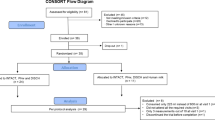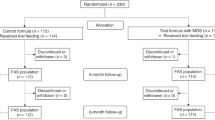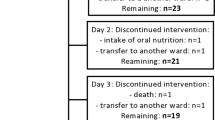Abstract
Objective:
To evaluate the efficacy and safety of an α-lactalbumin-enriched formula with a protein profile and total protein concentration closer to human milk (HM) and lower than conventional formulas.
Subjects/methods:
Two hundred and sixteen healthy, term infants, ⩽14 days post-natal age were enrolled and 166 (76.9%) completed the study. Timed post-prandial plasma essential amino-acid levels were determined after 8 weeks of ad libitum study feeding. Study events were assessed every 2 weeks.
Results:
At 8 weeks, all mean plasma essential amino-acid levels in the experimental formula (EF) group were as high as the standard formula (SF) and HM groups. The incidence of feeding-related gastrointestinal (GI) events varied significantly (P=0.025) across groups: SF (31.3%), EF (17.2%) and HM (13.6%), with SF being significantly higher than HM (P=0.015). Study withdrawals due to feeding-related GI events were significantly different (P=0.001) across groups: SF (12.5%), EF (4.7%), and HM (0%). The timing of GI events was also significantly different across groups (P=0.010).
Conclusion:
The study demonstrated that feeding a higher quality, lower protein concentration formula (α-lactalbumin-enriched) met all essential amino acid and protein requirements of infants. The GI tolerance profile of infants receiving the EF was similar to HM-fed infants.
This is a preview of subscription content, access via your institution
Access options
Subscribe to this journal
Receive 12 print issues and online access
$259.00 per year
only $21.58 per issue
Buy this article
- Purchase on Springer Link
- Instant access to full article PDF
Prices may be subject to local taxes which are calculated during checkout



Similar content being viewed by others
References
Agostini C, Carratu B, Boniglia C, Riva E, Sanzini E (2000). Free amino acid content in standard infant formulas: comparison with human milk. J Am Coll Nutr 19, 434–438.
Alarcon PA, Tressler RL, Mulvaney A, Lam W, Comer GM (2002). Gastrointestinal tolerance of a new infant milk formula in healthy babies: an international study conducted in 17 countries. Nutrition 18, 484–489.
Brodbeck U, Denton WL, Tanahashi N, Ebner KE (1967). The isolation and identification of the B protein of lactose synthetase as alpha-lactalbumin. J Biol Chem 242, 1391–1397.
Dewey KG, Beaton G, Fjeld C, Lonnerdal B, Reeds P (1996). Protein requirements of infants and children. Eur J Clin Nutr 50, 5119–5150.
Dibley MJ, Goldsby JB, Staehling NW, Trowbridge FL (1987). Development of normalized curves for the international growth reference: historical and technical considerations. Am J Clin Nutr 46, 736–748.
Fazzolari-Nesci A, Domianello D, Sotera V, Raiha NCR (1992). Tryptophan fortification of adapted formula increases plasma tryptophan concentrations to levels not different from those found in breast-fed infants. J Pediatr Gastroenterol Nutr 14, 456–459.
Hanning RM, Paes B, Atkinson SA (1992). Protein metabolism and growth of term infants in response to a reduced-protein, 40:60 whey:casein formula with added tryptophan. Am J Clin Nutr 56, 1004–1011.
Heine W, Radke M, Wutzke KD, Peters E, Kundt G (1996). Alpha-lactalbumin-enriched low-protein infant formulas: a comparison to breast milk feeding. Acta Paediatr 85, 1024–1028.
Heine WE, Klein PD, Reeds PJ (1991). The importance of alpha-lactalbumin in infant nutrition. J Nutr 121, 277–283.
Jackson JG, Janszen DB, Lonnerdal B, Lien EL, Pramuk KP, Kuhlman CF (2004). A multinational study of alpha-lactalbumin concentrations in human milk. J Nutr Biochem 15, 517–521.
Janas LM, Picciano MF, Hathch TF (1987). Indices of protein metabolism in term infants fed either human milk or formulas with reduced protein concentration and various whey/casein ratios. J Pediatr 110, 838–848.
Karlsland Akeson PM, Axelsson IEM, Raiha NCR (1998). Protein and amino acid metabolism in three-to twelve-month old infants fed human milk or formulas with varying protein concentrations. J Pediatr Gastroenterol Nutr 26, 297–304.
Kelleher SL, Chatterton D, Nielsen K, Lonnerdal B (2003). Glycomacropeptide and alpha-lactalbumin supplementation of infant formula affects growth and nutritional status in infant rhesus monkeys. Am J Clin Nutr 77, 1261–1268.
Kuczmarski RJ, Ogden CL, Grummer-Strawn LM et al. (2000). CDC growth charts: United States. Advance data from vital and health statistics; no. 314. Hyattsville, Maryland: National Center for Health Statistics.
Lepage N, McDonald N, Dallaire L, Lambert M (1997). Age-specific distribution of plasma amino acid concentrations in a healthy pediatric population. Clin Chem 43, 2397–2402.
Lien EL (2003). Infant formulas with increased concentrations of alpha-lactalbumin. Am J Clin Nutr 77 (Suppl), 1555S–1558S.
Lien EL, Davis AM, multi-center group (2004). Growth and safety of a reduced protein formula enriched with bovine alpha-lactalbumin in term infants. J Pediatr Gastroenterol Nutr 38, 170–176.
Lloyd B, Halter RJ, Kuchan MJ, Bags GE, Ryan AS, Masor ML (1999). Formula tolerance in post-breastfed and exclusively formula-fed infants. Pediatrics 103, E7.
Lonnerdal B (1994). Digestibility and absorption of protein in infants. In: Raiha NCR (ed.), Protein Metabolism During Infancy. Raven Press: Vevey 33, pp 53–65.
Lonnerdal B, Chen CL (1990). Effects of formula protein level and ratio on infant growth, plasma amino acids and serum trace elements. Acta Paediatr Scand 79, 257–265.
Lonnerdal B, Glazier C (1985). Calcium binding by alpha-lactalbumin in human milk and bovine. J Nutr 115, 1209–1216.
Lonnerdal B, Hernell O (1998). Effects of feeding ultrahigh-temperature (UHT)-treated infant formula with different protein concentrations or powdered formula, as compared with breast-feeding, on plasma amino acids, hematology, and trace element status. Am J Clin Nutr 68, 350–356.
Lonnerdal B, Lien E (2003). Nutritional and physiologic significance of alpha-lactalbumin in infants. Nutr Rev 61, 295–305.
Pamblanco M, Portoles M, Paredes C, Ten A, Comin J (1989). Free amino acids in preterm and term milk from mothers delivering appropriate- or small-for-gestational-age infants. Am J Clin Nutr 50, 778–781.
Picone TA, Benson JD, Moro G, Minoli I, Fulconis F, Rassin DK et al. (1989). Growth, serum biochemistries, amino acids of term infants fed formulas with amino acid and protein concentrations similar to human milk. J Pediatr Gastroenterol Nutr 9, 351–360.
Ren J, Stuart DI, Acharya KR (1993). Alpha-lactalbumin possesses a distinct zinc binding site. J Biol Chem 268, 19292–19298.
Rerat A (1995). Nutritional value of protein hydrolysis products (oligopeptides and free amino acids) as a consequence of absorption and metabolism kinetics Arch. Tierernahr 48, 23–36.
Rudolff S, Kunz C (1997). Protein and non-protein nitrogen components in human milk, bovine milk, and infant formula: quantitative and qualitative aspects of infant nutrition. J Pediatr Gastroenterol Nutr 24, 328–344.
Svangerb U, Gebre-Medhin M, Ljungqvist B, Olson M (1977). Breast milk composition in Ethiopian and Swedish mothers: III Amino acid and other nitrogenous substances. Am J Clin Nutr 30, 499–507.
Wenzel U, Meissner B, Doring F, Daniel H (2001). PEPT1-mediated uptake of dipeptides enhances the intestinal absorption of amino acids via transport system b(0,+). J Cell Physiol 186, 251–259.
World Health Organization Global Strategy for Infant and Young-Child Feeding (2003). Fifty-fourth WHA a54/INF.DOC/4 (Resolution WHA 54.2).
Acknowledgements
This study was funded by a grant from Wyeth Nutrition (Collegeville, PA, USA). This study would not have been possible without the diligent work from each of the following 12 investigators and their study staff at each site: Jeffrey Adelglass, MD (Dallas, Texas); William Brown, MD (Murfreesboro, Tennessee); Gloria Durelli, MD (Stratford, New Jersey); Martin Greenberg, MD (Savannah, Georgia); Frank Hughes, MD (Bossier City, Louisiana); John A Fling, MD (Fort Worth, Texas); Cyndy Lively, MD (Winston-Salem, North Carolina); Douglas K. Mitchell, MD (Norfolk, Virginia); Kathleen Salter, MD (Chapel Hill, North Carolina); Richard Schwartz, MD (Vienna, Virginia); John Spitzer, MD (Kalamazoo, Michigan); Tracy Stewart, MD (Little Rock, Arkansas).
A special thanks to Nicole Stouffer, MS, Biostatistician consultant, and Robert Paul Felton, Biostatistician from Biotechnical Services Inc., N Little Rock, AR and Susan Troemel, BS, Wyeth, Collegeville, PA, USA, for their expert contributions.
Author information
Authors and Affiliations
Corresponding author
Additional information
Guarantor: B Harris.
Contributors: AMD, BJH and ELL designed the study. AMD, BJH and the Multi-Center Group collected the data. AMD, BJH, ELL, KP and JT conducted data analysis and interpretation. AMD, BJH, ELL, KP and JT wrote the manuscript.
Rights and permissions
About this article
Cite this article
Davis, A., Harris, B., Lien, E. et al. α-Lactalbumin-rich infant formula fed to healthy term infants in a multicenter study: plasma essential amino acids and gastrointestinal tolerance. Eur J Clin Nutr 62, 1294–1301 (2008). https://doi.org/10.1038/sj.ejcn.1602848
Received:
Revised:
Accepted:
Published:
Issue Date:
DOI: https://doi.org/10.1038/sj.ejcn.1602848
Keywords
This article is cited by
-
Gold/alpha-lactalbumin nanoprobes for the imaging and treatment of breast cancer
Nature Biomedical Engineering (2020)
-
Milk Allergen Detection: Sensitive Label-Free Voltammetric Immunosensor Based on Electropolymerization
BioNanoScience (2020)
-
Frühe Adipositasprävention
Pädiatrie & Pädologie (2016)
-
Effect of an α-lactalbumin-enriched infant formula with lower protein on growth
European Journal of Clinical Nutrition (2011)
-
α-Lactalbumin-enriched and probiotic-supplemented infant formula in infants with colic: growth and gastrointestinal tolerance
European Journal of Clinical Nutrition (2010)



